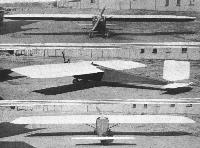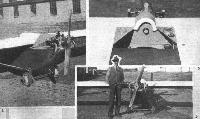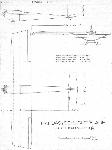
Flight, August 1923
THE HANDASYDE LIGHT 'PLANE
750 c.c. Douglas Engine
LAST week we published the first photograph of Raynham's light 'plane, designed by Mr. Handasyde and built by the Air Navigation and Engineering Company, Ltd., of Addlestone. This machine, designed for the competitions for the Sutherland, Daily Mail, and other prizes, is a straightforward miniature monoplane, with the wing resting on top of the fuselage and the pilot placed in a cut-out portion of the trailing edge. Thus the machine is not of the "glider" type, in which both pilot and engine are placed ahead of the wing, as in the "Wren," designed by Mr. Manning and built by the English Electric Company of Preston.
Although the outline design differs from that of the glider used by Raynham at Itford last year, the construction is in the main the same, with a few modifications here and there. The fuselage is of rectangular section, terminating at the stern in a horizontal knife-edge. It is entirely ply-wood covered, whereas the wing and tail are covered with fabric.
The 750 c.c. Douglas flat-twin air-cooled engine is mounted on a very simple engine plate in the nose of the machine, and the petrol and oil tank is supported aft of the engine on two transverse beams running across the fuselage. As the engine is mounted fairly high, and the tank is but little above it, there is not sufficient head to enable direct gravity feed to be used. However, for the small sizes and capacities involved there is probably no objection to a pressure petrol feed. The engine can be very quickly removed from the fuselage, and is very accessible, mounted as it is on the top of the forward end of the longerons. The drive is direct, and no flywheel is fitted, the propeller being of sufficient weight to take its place.
The wing is built in one piece, and is attached to the top longerons by simple steel fittings of the type indicated in a sketch. The wing construction is similar to that of last year's Handasyde glider, the large spar being a ply-wood covered box, which gives very great rigidity and is especially good in resisting torsion. The wing is not, however, a pure cantilever, but is externally braced by a tube to the front spar and a wire to the rear spar. As the wing section used is one of the Gottingen series, in which the centre of pressure is very far back, this form of bracing is probably quite satisfactory. Another advantage of this section is that with the c.p. well back the pilot's cockpit need not be very far forward in the section to trim the machine. Thus in the Handasyde light 'plane the machine trims with the cockpit placed just aft of the spar, so that only the trailing edge need be cut away. A narrow fairing runs from just aft of the engine to the pilot's cockpit, and contains in its forward portion the fuel tank. This fairing is only about a foot wide, and thus enables the pilot to look past it.
From the cockpit a very good view is obtained when flying, and especially when coming in to land, with the tail well up, but for climbing it would seem that the wing must obstruct the view considerably, although in this respect the machine is probably no worse than the pre-War monoplanes in which the pilots sat between the wing spars. The dials of the various instruments are fitted flush with the deck of the fuselage, where they can be easily seen and are in full daylight. The controls are of usual type, and call for no comment.
There is neither fixed tail plane nor vertical fin on the Handasyde light 'plane, the rudder as well as the elevator being cantilevers, and of fairly thick section. The rudder is balanced by a fairly large area being ahead of the pivot, and the elevator also is balanced by the leading edge being ahead of the hinge line. The elevator is tapered in chord and thickness from centre to tip, but it is of interest to note that in the case of the main plane the taper does not begin until a considerable distance out from the centre. This results in deep spars over the whole of the inner portion of the wing, and gives greater torsional strength than would a wing which began to taper immediately from the fuselage.
The undercarriage is of the simplest possible type, as shown in one of our sketches. The axle rests in slots in two short wood struts, which, in view of their short length, are strong enough to take the loads without having to be braced either fore and aft or laterally. In other words, they are short cantilevers, and are joined together by a transverse member in the form of a half-tube in which the axle rests. Raynham has had the machine painted in his racing colours, i.e., the wings and tail are bright yellow and the fuselage dark grey, making quite a distinctive combination.
- Flight, August 1923
THE HANDASYDE LIGHT 'PLANE
Фотографии
-
Flight 1923-09 / Flight
RAYNHAM'S HANDASYDE LIGHT 'PLANE: This machine is fitted with a Douglas flat twin air-cooled engine.
-
Aeroplane Monthly 1985-01 / R.Riding - Handasyde monoplane /British pre-war ultralights/ (46)
The Handasyde Monoplane at Brooklands in September 1923. It was painted in the Handasyde house colours of yellow and grey.
-
Aeroplane Monthly 1985-01 / R.Riding - Handasyde monoplane /British pre-war ultralights/ (46)
Great activity at Brooklands, possibly in September 1923, as the Douglas flat twin, air-cooled engine is run up.
-
Aeroplane Monthly 1985-01 / R.Riding - Handasyde monoplane /British pre-war ultralights/ (46)
Front view of the Handasyde showing the absence of dihedral.
-
Flight 1923-09 / Flight
THREE VIEWS OF RAYNHAM'S LIGHT 'PLANE, WITH 750 c.c. DOUGLAS ENGINE: This machine is a miniature monoplane of semi-cantilever type. The wing is braced on each side by one strut and one wire. The Douglas engine drives the tractor screw direct. The wing and tail are painted yellow (Raynham's racing colour) and the fuselage dark grey.
-
Aeroplane Monthly 1985-01 / R.Riding - Handasyde monoplane /British pre-war ultralights/ (46)
This view of the Handasyde Monoplane shows the position of the cockpit, from which the pilot had virtually no downward view at all. The tailplane was of the all-moving type and there was no fin.
-
Aeroplane Monthly 1985-01 / R.Riding - Handasyde monoplane /British pre-war ultralights/ (46)
Close-up of the Douglas engine. Fuel was carried in a tank faired in behind the engine.
-
Flight 1923-09 / Flight
THE HANDASYDE LIGHT 'PLANE: On the left, a view of the nose, showing the Douglas engine and the small-diameter direct-driven airscrew. The undercarriage is of very simple form, two short cantilever struts carrying the axle and rubber shock absorbers. On the right is shown, above, the pilot's cockpit, with the various instruments. Below, Raynham is seen standing by his machine. This photograph gives a good idea of the small overall height of the machine.
-
Aeroplane Monthly 1985-01 / R.Riding - Handasyde monoplane /British pre-war ultralights/ (46)
The pilot Freddy Raynham, seen giving scale to the Handasyde at Brooklands
-
Flight 1923-10 / Flight
LIGHT 'PLANE COMPETITIONS: The official "shed." No. 8, one of the de Havilland machines, and No. 13, the Handasyde monoplane, in the shed ready for filling up.
Другие самолёты на фотографии: De Havilland Humming Bird / D.H.53 - Великобритания - 1923
-
Aeroplane Monthly 1985-01 / R.Riding - Handasyde monoplane /British pre-war ultralights/ (46)
The Handasyde Light Monoplane: On the left Raynham in the cockpit of his machine, and on the right taking off.
Composite picture showing Raynham in the Handasyde’s cockpit. -
Flight 1923-11 / Flight
LIGHT 'PLANES AT HENDON: 5. Raynham on the Handasyde monoplane (Douglas engine).
-
Aeroplane Monthly 1985-01 / R.Riding - Handasyde monoplane /British pre-war ultralights/ (46)
Two views of the Handasyde in the air at the Lympne trials during the second week of October 1923. The pilot is Freddy Raynham.
-
Flight 1923-11 / Flight
LIGHT 'PLANES AT HENDON: "Jimmy" James banking - and leading - in the third heat of the Handicap Race. Close behind are F.P.Raynham (left) on the Handasyde and (right) Capt. Macmillan on Parnall "Pixie II."
Другие самолёты на фотографии: ANEC I / II - Великобритания - 1923Parnall Pixie - Великобритания - 1923
-
Aeroplane Monthly 1985-01 / R.Riding - Handasyde monoplane /British pre-war ultralights/ (46)
The unusual instrument layout of the Handasyde, some of which must have been difficult for the pilot to keep an eye on.
-
Flight 1923-09 / Flight
RAYNHAM'S HANDASYDE LIGHT 'PLANE: Some constructional details. 1. Aileron hinge and crank. 2. Split pin locking device for elevator hinge pins, and elevator crank. 3. Attachment of wing to fuselage. 4. Details of the very simple undercarriage. 5. Mounting of the petrol and oil tank.
-
Flight 1923-09 / Flight
Handasyde Light 'Plane 750 c.c. Douglas Engine
- Фотографии

















